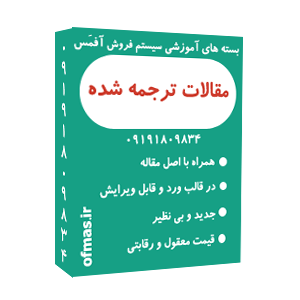ترجمه مقاله اثر جریان و زمان جوشکاری بر ریزساختار، مشخصه های مکانیکی و مطالعه شکست اتصلات جوشکاری مقاومتی نقطه ای در فولاد ضدزنگ آستنیتی AISI 316L در 28 صفحه ورد قابل ویرایش با فرمت doc به همراه اصل مقاله انگلیسی
| عنوان انگلیسی مقاله | Effect of Welding Current and Time on the Microstructure, Mechanical Characterizations, and Fracture Studies of Resistance Spot Welding Joints of AISI 316L Austenitic Stainless Steel |
| عنوان فارسی مقاله | اثر جریان و زمان جوشکاری بر ریزساختار، مشخصه های مکانیکی و مطالعه شکست اتصلات جوشکاری مقاومتی نقطه ای در فولاد ضدزنگ آستنیتی AISI 316L |
| تعداد صفحات و فرمت | 28 صفحه ورد قابل ویرایش با فرمت doc |
| شناسه ثبت محصول | ss25 |
| سطح ترجمه | عالی |
| لینک دانلود اصل مقاله انگلیسی | http://ofmas.ir/tarjome/ss25.pdf |
| دانلود فایل ترجمه | بلافاصله پس از پرداخت آنلاین 31900 تومان قادر به دانلود فایل خواهید و یک نسخه لینک دانلود نیز برای شما ایمیل می شود . |
بخشی از ترجمه :
چکیده :
این مقاله قصد دارد اثر پارامترهای جوشکاری به نامهای جریان و زمان آن را بر جوشکاری نقطه ای مقاومتی RSW فولاد ضد زنگ آستنیتی AISI 36L بررسی کند.تاثیر زمان و جریان جوش بر خواص جوش شامل قطر ناحیه ذوب شده یا قطعه جوش ، ظرفیت تحمل بار کششی برشی مواد جوش شده ، حالت شکست ، جذب انرژی ،و ریزساختار ناحیه جوش بررسی خواهد شد. مطالعات ریزساختاری و خواص مکانیکی نشان می دهد که ناحیه بین سطح مشترک تا حالت انتقال به خارج و حد بیرون شدگی به عنوان شرایط بهینه جوش تعریف می شود. مطالعه میکروسکوپیکی الکترونی انواع مختلفی از دلتا فریت را در ناحیه جوش شامل اسکلتی ، سوزنی و دلتا فریت نبشی مانند ناشی از فازهای غیر تعادلی که بدلیل نرخ سردشدن سریع در فرآیند RSW می باشد را نشان می دهد. این ریخت شناسی ها (مورفولوژی) براساس شافلر ، WRC 1992 و دیاگرام فازی شبه باینری توضیح داده می شوند. ریزساختار بهینه و خواص مکانیکی با جریان 8 کیلوآمپر و زمان 4سیکل در حالتی که ماکزیمم ظرفیت تحمل بار کششی برشی یا بار پیک مواد جوشکاری شده در 8070 نیوتن انتخاب شده بود ، حاصل شد و حالت شکست از نقطه خروج با پاره شده شدن از فلز پایه قرار گرفت. در نهایت مطالعات سطح شکست نشان داد که فرورفتگی های درازی برروی سطح ظاهر شدند که نتیجه سکشت نرم در نمونه های جوش داده شده در شرایط بهینه جوش می باشد.
ABSTRACT:
This article aims at investigating the effect of welding parameters, namely, welding current and welding time, on resistance spot welding (RSW) of the AISI 316L austenitic stainless steel sheets. The influence of welding current and welding time on the weld properties including the weld nugget diameter or fusion zone, tensile-shear load-bearing capacity of welded materials, failure modes, energy absorption, and microstructure of welded nuggets was precisely considered. Microstructural studies and mechanical properties showed that the region between interfacial to pullout mode transition and expulsion limit is defined as the optimum welding condition. Electron microscopic studies indicated different types of delta ferrite in welded nuggets including skeletal, acicular, and lathy delta ferrite morphologies as a result of nonequilibrium phases, which can be attributed to a fast cooling rate in the RSW process. These morphologies were explained based on Shaeffler, WRC-1992, and pseudo-binary phase diagrams. The optimum microstructure and mechanical properties were achieved with 8-kA welding current and 4-cycle welding time in which maximum tensile-shear load-bearing capacity or peak load of the welded materials was obtained at 8070 N, and the failure mode took place as button pullout with tearing from the base metal. Finally, fracture surface studies indicated that elongated dimples appeared on the surface as a result of ductile fracture in the sample welded in the optimum welding condition.

 دسته :
دسته :